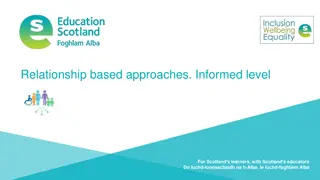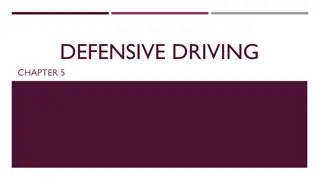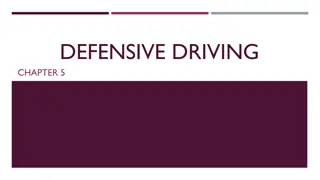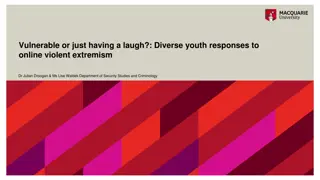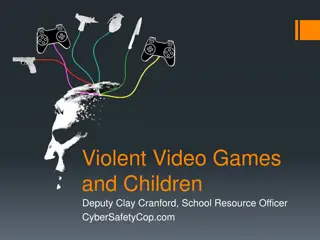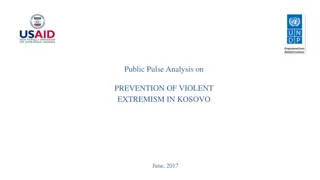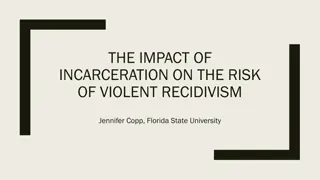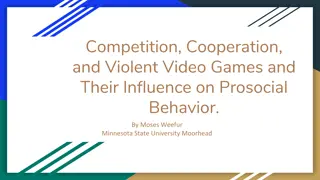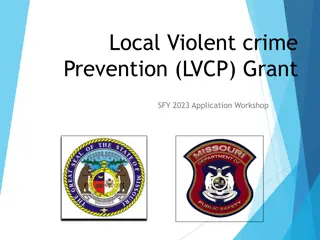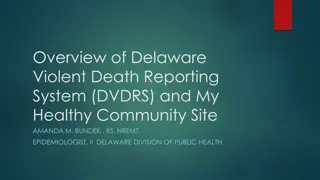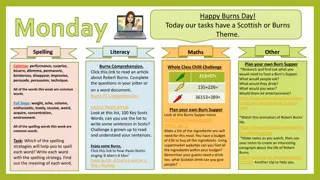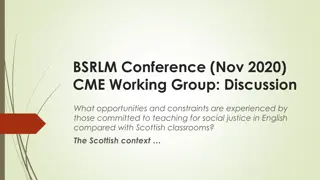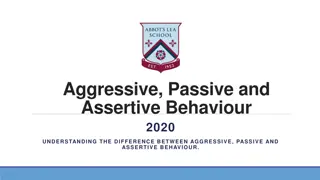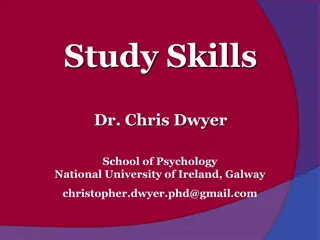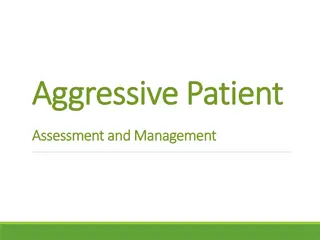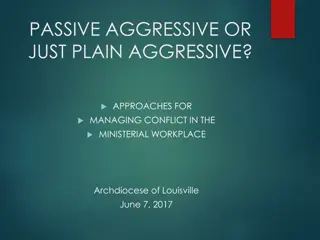Addressing Violent and Aggressive Behavior in Scottish Schools
Recent Stirling survey results reveal a concerning rise in violent and aggressive incidents towards teachers, highlighting systemic issues such as lack of investment in education, societal factors, and increased mental health issues. The lack of support and follow-up post-incident is a common issue faced by teachers, impacting their well-being and ability to effectively manage behaviors in the classroom.
Download Presentation

Please find below an Image/Link to download the presentation.
The content on the website is provided AS IS for your information and personal use only. It may not be sold, licensed, or shared on other websites without obtaining consent from the author.If you encounter any issues during the download, it is possible that the publisher has removed the file from their server.
You are allowed to download the files provided on this website for personal or commercial use, subject to the condition that they are used lawfully. All files are the property of their respective owners.
The content on the website is provided AS IS for your information and personal use only. It may not be sold, licensed, or shared on other websites without obtaining consent from the author.
E N D
Presentation Transcript
Stirling LA Reporting Violent & Aggression Behaviour This session will look at: Recent Stirling results from V&A survey What to do and expect after a V&A incident Next steps for school branches Opportunity for questions Ann Skillen EIS Stirling LA Secretary Dan Auldjo EIS Stirling LA President Craig Carson EIS Organiser
Backgroundhow did we get here? Violent and aggressive behaviour in classrooms is not a new phenomenon, but it has increased exponentially in the last ten years. Reasons for this include: Year upon year of systemic lack of investment in Scottish schools; Societal factors poverty, increases in mental health issues, cuts to support services Covid the lockdown compounded existing issues and inhibited social and emotional development. Many young people experienced delayed speech and language skills; Lack of real investment in Education Recovery; Since 2010, ASN numbers have been increasing. In December 2023, the Scottish Government reported that 37% of school children have an ASN; Teacher numbers are falling, and specialist teachers are diminishing; We have large class sizes and the third highest contact time of all OECD countries. Schools can t deal with this alone.
Stirling Pupil-on-Teacher results School branches reported that: 40% experience V&A incidents on a daily basis (28% weekly, 4% monthly & 28% rarely) 86% answered that V&A incidents have increased over past 4 years (12% no change & 4% decreased significantly) The most common types of V&A incidents towards teachers were: Physical violence (71%) Verbal threats (67%) Physically intimidatory or aggressive behaviour, including obscene gestures (50%) 64% said members were aware of the school s V&A policies & procedures (24% yes & 12% didn t know) That 75% felt sometimes teachers were supported after a V&A incident had been reported (17% always & 8% never)
Comments about support after a pupil-on-teacher V&A incident The volume of incidents that occur is such that it is nearly impossible for senior leadership to follow up on every incident. There is very little meaningful support or feedback from the local authority following incident reports, even more serious incidents. We are supported at school level but not beyond. Sometimes after an incident there isn't enough time, even after really serious incidents. Sometimes there aren't enough staff around to support, again this is even at the most difficult times. Sometimes there isn't sufficient follow up after an incident. It can feel that we are only managing when the behaviour occurs rather than preventing it. Some people feel there are not sufficient consequences. Teacher often feels blamed and the child's violent behaviour explained away by teacher failings or the child's young age, additional needs/ACES.
Comments on ways teachers could be better supported after a pupil- on-teacher V&A incident We are a small school and often do not have flexibility in staffing to allow for "recovery time". We are very supportive of each other, but the main issue is lack of staff. We are not given time out to recover. No chance to talk it through and no effective sharing of risks. The way of reporting is far too time consuming and prevents it from being achievable to report every incident. It is only feasible to report the higher level incidents and not the lower level consistent incidents. Our school does not have enough resources, in staffing, supportive resources and also space. Reporting seems to have little impact upon the support in place to help reduce these incidents. Yes, restorative practice and not a five minute time out and then back to class. Follow-up with staff involved to ensure they are ok after incidents occur. Update risk assessments with class teacher and shared with the adults working with that child.
Stirling Pupil-on-Pupil results School branches reported that: 48% dealt with daily incidents of V&A (32% weekly, 8% monthly, 12% rarely) 80% felt V&A incidents had increased in frequency over past 4 years (8% no change & 12% no change) Most common types of pupil-on-pupil V&A incidents: Verbal threats (68%) Physical violence (60%) Intimidatory, obscene or derogatory verbal comments towards another pupil (48%) 44% stated that V&A incidents driven by prejudice had stayed the same over the past 4 years (40% increased & 16% didn t know) 52% said V&A behaviours were more commonly shown by boys (20% no difference & 28% didn t know)
Stirling Parent-on-Teacher results School branches reported that: 48% rarely experience parental aggression (20% termly, 8% monthly & 16% never) 68% stated there was no change in the frequency of parental aggression towards teachers (28% more frequent & 4% less frequent) The following behaviours from parents towards one of more branch members: Derogatory comments or gossiping about a teacher (61%) Intimidatory, threatening or derogatory emails, phone calls, SMS or letters to a teacher (57%) Intimidatory, obscene or derogatory verbal comments to a teacher (48%) 42% felt that they were sometimes supported after an incidence of aggression from a parent/carer (42% always & 17% never)
Definition of Violence Stirling Council use the Health and Safety Executive definition:- Any incident in which a person is abused, threatened or assaulted in circumstances relating to their work. The HSE include the following: verbal abuse or threats, including face to face, online and via telephone physical attacks This might include violence from members of the public, customers, clients, patients, service users and students towards a person at work.
Key Policies and Procedure Manuals Council documentation and guidance on Incident Reporting can be found on The Source:- http://source.stirling.gov.uk/pages/h-s- incident-reporting-2 Members will also be able to access the Council s Incident Reporting and Investigation Guidance document, however
Those working in Schools and Nurseries should use this flow chart below
INCIDENT REPORTING AND CORPORATE INCIDENT FORMS (CIFs) What is an Incident? an accident that results in injury or ill health. a near miss not causing harm, but has the potential to cause injury or ill health. Verbal and Physical abuse of staff must be reported. Why report Incidents? employers need to provide a safe working environment, and Incident Reporting is key to informing the employer of actual and potential incidents and accidents. Incident Reporting is used to inform the Risk Assessment process and to identify possible risks. to help identify where extra support can be offered or may be needed. How to report an Incident or Accident employees should (where possible) complete Sections 1 and 2 of a Corporate Incident Form line managers should then complete Section 3 LINE MANAGERS MUST ENSURE THE EMPLOYEE COMPLETING SECTIONS 1 AND 2 IS COPIED INTO THE EMAIL WHEN SUBMITTING THE COMPLETED FORM TO THE HEALTH AND SAFETY TEAM. FORMS MUST NOT BE SHARED FURTHER
Incident Forms can be downloaded from The Source - these will always be the most up to date version. Employees should, where possible, complete both Section 1 and 2, as shown here. When completing the description of the incident, staff should:- Be factual when describing the incident Should NOT include names of pupils but use initials instead Include information that fully explains the incident
The section for describing the incident will expand as needed, to allow for a factual explanation of what happened. Again, when completing it, staff should:- summarise what happened record who was involved (pupil initials only) give details of any injuries
INCIDENT REPORTING AND CORPORATE INCIDENT FORMS (CIFS) What to expect Once Sections 1 and 2 have been filled in, Section 3 should be completed by the Line Manager. Section 3 should detail meaningful Corrective and Preventative measures. Line Managers should ensure the staff member completing Sections 1 and 2 is copied into the email when submitting the form to the Health and Safety team. This ensures all parties are aware it has been submitted. Where in place and relevant, Risk Assessments should be reviewed as a team, or devised and put in place if need be. Schools may wish to discuss reported incidents at their own Health and Safety Committee meetings to identify if there are further corrective measure to be taken. When forms report Verbal and Physical abuse of staff Staff should expect an email acknowledging the incident Staff will be offered support and advice If several reports identify a common cause, help will be offered to reduce the chance of it occurring again. Employees can seek further advice from their Line Managers or Trade Union representatives on any of the above.
Flow Chart for Incidents Involving Staff Support required/ scene made safe? An incident occurs Is staff member safe? Is there an injury? Physical Harm Emotional Harm Check in with staff member Counselling Service offered Counselling Service offered First aid offered Debrief of Incident Check in with Staff Debrief of Incident
Flow Chart for Incidents Involving Pupils To be undertaken as soon as practicable
At a local level The EIS have been raising this issue with Stirling Council both at formal and informal meetings. Local LA has been meeting elected members to inform them of our V&A survey results and to look for their support in addressing issues.
https://www.eis.org.uk/Content/images/Campaigns/QualityEducation/VASU4QEBranches.pdfhttps://www.eis.org.uk/Content/images/Campaigns/QualityEducation/VASU4QEBranches.pdf
Next steps for members & branches No EIS rep in your school? Consider being the rep! Violence is a Health and Safety issue. Health and Safety Reps have a huge role in this area. Have you considered being one? Encourage people to report. Reporting won t solve everything, but not reporting means that the true scale of the problem is never fully understood. This also means that the pupils involved may never access the support they need because appropriate reporting doesn t take place. Campaign for appropriate support for teachers following a violent incident, e.g. minimum level of support (space, time for recovery, risk assessment, investigation). Hold a meeting with branch members. What would a minimum level of support look like? Ask for a meeting with your HT/SLT. Remind people that accident/incident claims can be made through the EIS especially if the incident was foreseeable and preventable. Remind members that this is a wider, societal issue. Don t enter into the blame game e.g. He/she was fine with me last year Support each other. Build confidence in each other.



